When it comes to planting alfalfa, timing is everything. Fall is an excellent time to plant alfalfa, especially in regions with milder climates. In fact, planting alfalfa in the fall can yield maximum yields. However, growers need to be mindful of the optimal time to plant to ensure a successful crop.
Alfalfa is a cool-season crop that thrives in cooler temperatures. Therefore, growers should aim to plant alfalfa in the fall when the temperatures are cooler. Planting in the fall will also provide the plant with enough time to develop roots before the winter season arrives.
In regions with milder climates, planting in the fall will also provide the plant with enough time to establish before the hot summer months.
Key Takeaways
- Fall is an excellent time to plant alfalfa, especially in regions with milder climates.
- Planting alfalfa in the fall can yield maximum yields.
- Alfalfa is a cool-season crop that thrives in cooler temperatures.
Also see:
- When to Plant a Tree in Texas?
- When to Plant Grass Seed in Maine?
- When to Plant Grass Seed in Massachusetts?
Understanding Alfalfa

Alfalfa is a perennial plant that is grown as a forage crop for livestock. It is a member of the legume family and is known for its high protein content and nutritional value. Alfalfa is commonly used for hay production and is also used as a grazing crop for livestock.
The leaves of the alfalfa plant are the primary source of nutrition for livestock. They are high in protein, vitamins, and minerals. When alfalfa is harvested for hay, the leaves are typically the most valuable part of the plant and are often sold separately as a premium product.
There are many different varieties of alfalfa available, each with its own unique characteristics. Some varieties are better suited for hay production, while others are better suited for grazing. It is important to select the right variety for the intended use to ensure maximum yield and quality.
Fall is a popular time to plant alfalfa because the cooler temperatures and increased moisture provide ideal growing conditions. However, it is important to plant alfalfa at the right time to ensure successful establishment before winter.
Alfalfa should be planted at least 40 days before the first hard frost to allow for proper root development and winter survival.
When to Plant Alfalfa in the Fall
When it comes to planting alfalfa in the fall, timing is everything. The best time to plant alfalfa is during late summer or early fall, typically between mid-August and mid-September. This is because the cooler temperatures and higher moisture levels during this time provide optimal growing conditions for alfalfa.
One of the key factors to consider when determining the best time to plant alfalfa is the planting date. For spring seeding, planting should be done as early as possible to allow for maximum growth before the hot summer months.
In contrast, fall planting should be done at least 40 days before the first frost to allow for proper growth and establishment before winter.
It is important to note that the optimal planting dates can vary depending on your location and climate. For example, those living in cooler climates can plant alfalfa in the spring, while milder regions should opt for fall planting.
Another important consideration is seeding dates. Alfalfa should be seeded when soil moisture is adequate, and the soil temperature is between 50-86°F (10-30°C). It is also important to ensure that the soil is free of weeds and other debris before planting.
Optimal Soil Conditions for Alfalfa
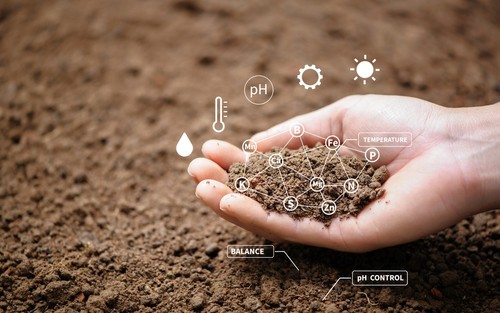
Alfalfa requires specific soil conditions to thrive. The ideal soil for alfalfa is well-drained, loamy soil with a neutral pH level between 6.8 and 7.1. Soil acidity can negatively affect alfalfa growth, so it is essential to maintain a neutral pH level.
Farmers can use lime to raise the pH level of acidic soil. However, it is important to note that over-liming can have adverse effects on soil fertility and alfalfa growth. Therefore, it is crucial to perform a soil test to determine the optimal amount of lime required to reach the desired pH level.
In addition to pH level, soil moisture is also a critical factor in alfalfa growth. Alfalfa requires adequate soil moisture, but wet soils can cause problems during planting. Therefore, farmers should wait until the soil has adequate moisture but is not too wet before planting alfalfa.
It is also important to consider the soil type when planting alfalfa. Alfalfa can grow in a variety of soil types, but it thrives in well-drained loamy soil. If the soil is too sandy, it may not hold enough moisture for alfalfa to grow properly. On the other hand, if the soil is too heavy, it may not drain well, which can cause root rot and other issues.
Farmers can improve soil conditions for alfalfa by adding soil conditioners, such as compost or manure. These soil conditioners can improve soil structure and nutrient content, which can help alfalfa grow more robustly.
However, it is essential to use caution when adding soil conditioners, as over-application can lead to nutrient imbalances and other issues.
Preparing the Seedbed
When planting alfalfa in the fall, it is important to prepare a firm seedbed. A firm seedbed provides good seed-to-soil contact, which is essential for successful germination and establishment of alfalfa. Here are some steps to follow when preparing a firm seedbed:
1. Check Weed Pressure
It is important to assess weed pressure before planting alfalfa. If there is a high weed pressure, it is recommended to control weeds before planting. This can be done by using herbicides or tillage.
2. Soil Preparation
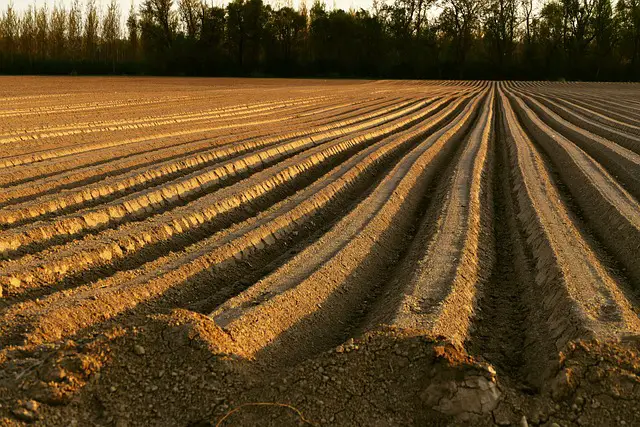
The soil should be prepared by tilling or disking to create a smooth and firm seedbed. The soil should be free of clods and debris to ensure good seed-to-soil contact.
3. Seeding Depth
The seeding depth should be between 1/4 to 1/2 inch. Planting too deep can result in poor germination and establishment.
4. Seeding Rate
The seeding rate for alfalfa should be between 12 to 15 pounds per acre. Using a drill is recommended for accurate seed placement.
5. Firm Seedbed
A firm seedbed is essential for good seed-to-soil contact. An easy way to check if the seedbed is firm enough is to walk on it. If footprints are more than 1/4 inch deep, the seedbed needs to be firmed up.
By following these steps, a firm seedbed can be achieved, which will result in successful establishment of alfalfa in the fall.
Managing Moisture and Sunlight
When planting alfalfa in the fall, managing moisture and sunlight is crucial for the success of the crop. Alfalfa requires full sun to grow, so it is important to select a location with ample sunlight and minimal shade. Alfalfa is drought-resistant, but it still requires adequate moisture to establish and grow properly.
One way to manage moisture is to plant alfalfa in well-drained soils. Alfalfa grows best in soils with a pH between 6.5 and 7.5, and it prefers soils with good drainage to avoid waterlogging.
To ensure proper drainage, farmers can till the soil to create a seedbed that is loose and allows water to penetrate easily. Additionally, farmers can incorporate organic matter into the soil to improve its water-holding capacity.
Another way to manage moisture is to water the alfalfa regularly. Alfalfa requires at least 1 inch of water per week during the growing season, and farmers can use irrigation to supplement rainfall. It is important to avoid overwatering alfalfa, as this can lead to disease and reduced yields.
Sunlight is also important for alfalfa growth, as it is a sun-loving plant. Farmers can select a location that receives full sun for most of the day, and they can also manage the canopy of the alfalfa plants to ensure that they are not shaded by other plants or debris.
Farmers can also use reflective mulches or row covers to increase the amount of sunlight that reaches the plants.
Fertilizer and Nutrient Requirements

Alfalfa is a legume that can fix atmospheric nitrogen through symbiotic relationships with Rhizobia bacteria. However, to achieve optimal growth and yield, alfalfa requires other essential nutrients that may not be available in sufficient quantities in the soil.
These nutrients include phosphorus, potassium, sulfur, and micronutrients such as boron and zinc.
Before planting alfalfa, it is crucial to conduct a soil test to determine the pH, nutrient levels, and organic matter content. Soil pH should be between 6.5 and 7.5 for optimal growth and nodulation. If the soil pH is too low, lime can be added to increase it.
Phosphorus is essential for root development, energy transfer, and flower and seed production. The recommended phosphorus level for alfalfa is 40 to 60 pounds per acre. If the soil test indicates low phosphorus levels, it can be applied before planting or as a side-dress application during the growing season.
Potassium is necessary for water regulation, nutrient transport, and disease resistance. Alfalfa requires high levels of potassium, with a recommended level of 250 to 350 pounds per acre. Potassium can be applied before planting or as a top-dress application during the growing season.
Sulfur is a critical component of amino acids and protein synthesis. Alfalfa requires 20 to 30 pounds of sulfur per acre. Sulfur can be applied before planting or as a side-dress application during the growing season.
In addition to these essential nutrients, alfalfa may require micronutrients such as boron and zinc. Boron is necessary for cell division and root development, while zinc is essential for enzyme activity and protein synthesis. The recommended levels of boron and zinc are 1 to 2 pounds per acre and 2 to 3 pounds per acre, respectively.
Nitrogen fertilizer is generally not recommended for alfalfa because of its ability to fix atmospheric nitrogen. However, in some cases, such as when establishing a new stand or when nitrogen fixation is limited, a small amount of nitrogen fertilizer can be applied. The recommended rate of nitrogen fertilizer is 20 to 30 pounds per acre.
Weed and Pest Control
When planting alfalfa in the fall, it is important to consider weed and pest control. Weeds can reduce the yield, quality, and longevity of alfalfa stands. One way to control weeds in alfalfa is through the use of herbicides.
Glyphosate and Gramoxone are commonly used herbicides for controlling weeds in alfalfa. Glyphosate is effective against a wide range of weeds, while Gramoxone is more effective against broadleaf weeds.
However, it is important to note that herbicide carryover can be an issue. Herbicide carryover occurs when herbicides applied in previous seasons remain in the soil and affect the growth of the next crop. To avoid herbicide carryover, it is important to follow label instructions and use herbicides that are safe for the next crop.
Another way to control weeds in alfalfa is through mowing. Mowing can be a good control option for broadleaf weeds in newly seeded alfalfa stands.
Increasing the height when mowing can be a good strategy as well. This can slow the growth of broadleaf weeds, while allowing the alfalfa seedlings to re-grow with reduced weed competition.
In terms of pest control, there are pest-resistant varieties of alfalfa available. These varieties are bred to resist pests such as aphids, potato leafhoppers, and alfalfa weevils.
However, it is important to note that even pest-resistant varieties may still require pest management practices such as scouting and timely insecticide applications.
Alfalfa Planting Techniques
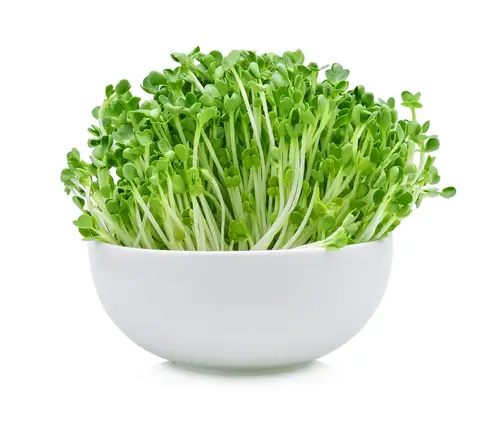
When planting alfalfa in the fall, there are several techniques that can be used to ensure a successful establishment. Alfalfa is a cool-season perennial plant with a deep root system that can reach up to 15 feet deep, making it an ideal forage crop for livestock and a soil conditioner.
Here are some techniques to consider when planting alfalfa:
1. Sowing Seeds
One popular way to propagate alfalfa is by sowing from seed. When buying seeds, choose ones that are rhizobium bacteria inoculated to help fix nitrogen in your soil immediately. Spring seed in clod-free, smooth yet firm seedbeds with at least 13 pounds of seed per acre. Plant seeds no more than a half-inch deep.
2. No-Till Planting
No-till planting is another technique that can be used to establish alfalfa. No-till planting is a technique where seeds are planted directly into the soil without disturbing the soil structure. This technique can help reduce soil erosion, conserve moisture, and improve soil health.
3. Stand Establishment
To establish a good stand of alfalfa, it is important to start with a clean seedbed. Remove all weeds and other debris from the field before planting. Alfalfa should be planted in well-drained soils with a pH between 6.5 and 7.5.
Soil fertility should also be considered when planting alfalfa. A soil test should be performed to determine nutrient levels in the soil.
4. Plant Depth
Alfalfa should be planted no more than a half-inch deep. Planting too deep can result in poor emergence and stand establishment. Planting too shallow can result in desiccation of the seed and poor seedling establishment.
5. Planting Density
Planting density is another important factor to consider when planting alfalfa. The recommended planting density for alfalfa is 60 to 80 pounds of seed per acre. Using too little seed can result in a thin stand, while using too much seed can result in competition for resources and a reduced yield.
By following these planting techniques, farmers can establish a healthy stand of alfalfa and ensure a successful crop.
Harvesting Alfalfa
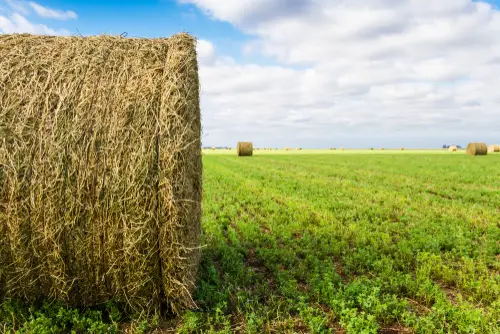
Harvesting alfalfa is an important process that can affect the yield and quality of the crop. According to the Alfalfa Production Handbook, the number of cuttings and the timing of each cutting can greatly impact the overall yield of the crop.
Typically, alfalfa is harvested three to five times per year, depending on the growing conditions and the management practices used. The first cutting usually occurs in late May or early June, while the subsequent cuttings are made every four to six weeks, depending on the rate of regrowth.
The timing of each cutting is critical, as it can affect the quality of the forage. The optimal time to harvest alfalfa is when the plants are in the bud or early bloom stage, as this is when the forage has the highest protein content and digestibility.
Waiting too long to harvest can result in a decline in quality, as the plants become more mature and lignified. In terms of yield, the number of cuttings and the timing of each cutting can greatly impact the overall production of the crop. According to the Alfalfa Production
Handbook, the first cutting typically yields the most tonnage, while subsequent cuttings may yield less. However, it is important to balance yield with forage quality, as harvesting too late can result in a decline in quality.
Potential Risks and Challenges
Planting alfalfa in the fall can be a risky endeavor due to various factors that can affect its growth and survival. Here are some of the potential risks and challenges that farmers may encounter when planting alfalfa in the fall:
1. Frost
One of the biggest risks when planting alfalfa in the fall is the possibility of an early frost. Frost can damage or kill young alfalfa plants, especially those that have not yet developed their trifoliate leaves.
To minimize the risk of frost damage, farmers should plant alfalfa early enough in the fall to allow the plants to establish themselves before the first frost.
2. Temperature
Temperature is another factor that can affect the growth and emergence of fall-planted alfalfa. If the temperature is too warm, the plants may emerge too quickly and become vulnerable to frost damage. On the other hand, if the temperature is too cold, the plants may not emerge at all, or their growth may be stunted.
3. Emergence
Fall-planted alfalfa may take longer to emerge than spring-planted alfalfa due to cooler soil temperatures. This delay in emergence can increase the risk of stand failure, especially if the soil is prone to erosion or has poor drainage. To improve emergence rates, farmers should ensure that the soil is well-drained and has adequate moisture.
4. Risk of Stand Failure
Fall-planted alfalfa is at a higher risk of stand failure than spring-planted alfalfa due to the harsh winter conditions that it may face. To minimize the risk of stand failure, farmers should plant alfalfa varieties that are winter-hardy and have good disease resistance.
They should also ensure that the soil is well-drained and has adequate fertility.
5. Phytophthora Root Rot
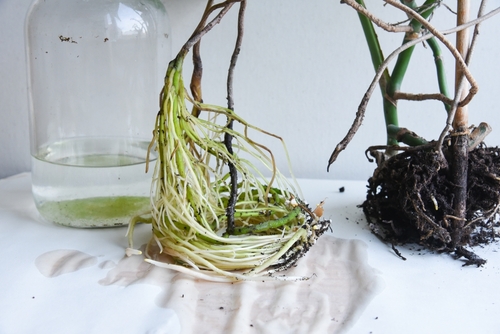
Phytophthora root rot is a fungal disease that can affect the roots of alfalfa plants, causing them to rot and die. This disease is more prevalent in poorly drained soils, especially in areas with heavy clay soils.
To minimize the risk of phytophthora root rot, farmers should avoid planting alfalfa in poorly drained soils and should choose varieties that are resistant to the disease.
6. Bacterial Wilt
Bacterial wilt is another disease that can affect alfalfa plants, causing them to wilt and die. This disease is more prevalent in warm, moist conditions, especially in areas with heavy soil.
To minimize the risk of bacterial wilt, farmers should avoid planting alfalfa in areas with heavy soil and should choose varieties that are resistant to the disease.
Alfalfa in Different Regions
Alfalfa is a versatile crop that can be grown in different regions and climates. However, the best time to plant alfalfa in the fall varies depending on the location and local climate.
In the United States, alfalfa is grown in different regions, including the Midwest, West, and South. In the Midwest, the best time to plant alfalfa in the fall is in August or early September. In the West, planting can be done in late August or early September, while in the South, it is recommended to plant in late September or early October.
The local climate is also an important factor to consider when planting alfalfa in the fall. Alfalfa prefers a cool and moist climate, and it can tolerate cold temperatures. However, it does not do well in hot and dry climates. Therefore, gardeners should check the local climate and weather forecast before planting.
Alfalfa has taproots that can grow up to 15 feet deep, which makes it an excellent cover crop. It can improve soil health by fixing nitrogen and adding organic matter to the soil. In addition, alfalfa can be used as green manure, which helps to prevent soil erosion and improve soil structure.
In California, alfalfa is one of the most important crops, and it is grown in different regions of the state. The best time to plant alfalfa in California is in the fall, between mid-August and mid-September. However, the planting time can vary depending on the location and local climate.
Economic Considerations
Planting alfalfa in the fall can be a profitable investment for farmers. Fall planting allows for earlier harvests in the following year, which can increase profits from alfalfa. Additionally, fall planting can offer stand establishment advantages over waiting until next spring.
The establishment cost for planting alfalfa in the fall can vary depending on several factors. For dryland fields, the cost can be lower due to reduced irrigation needs.
However, for irrigated fields, the cost can be higher due to increased water usage. Farmers should consider their specific field conditions and budget before deciding on fall planting.
It is important to note that planting alfalfa in the fall may not be suitable for all fields. Farmers should select fields with deep, well-drained soils to mitigate soil nutrient deficiencies. They should also annually sample soils to ensure that they have adequate nutrient levels for alfalfa growth.
For dairy farmers, planting alfalfa in the fall can be especially beneficial. Alfalfa hayfields help to supply forage that is highly digestible and high in protein, which can improve milk production in dairy cows. However, it is important to ensure that the alfalfa is harvested at the correct maturity level to maximize protein content.
Miscellaneous

When planting alfalfa in the fall, there are several factors to keep in mind to ensure a successful crop. Here are some miscellaneous tips to consider:
1. Variety Selection
When selecting a variety of alfalfa to plant in the fall, it is important to consider your specific location and climate. Some varieties are better suited to certain regions and growing conditions than others. For example, in Kansas, varieties with winter hardiness are recommended due to the harsh winter conditions.
2. Germination
To ensure good germination rates, it is important to plant alfalfa seeds at the correct depth and with good seed-to-soil contact. Planting too deep can cause poor emergence and slow growth, while planting too shallow can result in poor root development and susceptibility to drought stress.
3. Press Wheel
Using a press wheel after planting can help ensure good seed-to-soil contact and improve germination rates. The press wheel helps to firm the soil around the seed, which can help prevent the seed from drying out and improve the chances of successful germination.
4. Grass and Mold
When planting alfalfa in the fall, it is important to control any grass or weed growth in the field. Grass and weeds can compete with the alfalfa for nutrients and water, which can lead to reduced yields.
Additionally, mold can be a problem in wet conditions, so it is important to monitor the crop regularly and take steps to prevent mold growth.
5. Inoculation
Inoculating the seed with rhizobia bacteria can help improve nitrogen fixation in the soil, which can lead to better crop yields. It is important to choose the right inoculant for your specific variety of alfalfa and to follow the manufacturer’s instructions carefully when applying it to the seed.
By keeping these tips in mind, farmers can increase their chances of a successful alfalfa crop in the fall.
Frequently Asked Questions
What is the best time to plant alfalfa in the fall?
The best time to plant alfalfa in the fall is in late summer, around mid-August to early September. Planting at this time gives the alfalfa enough time to establish its root system before winter sets in.
How deep should alfalfa seeds be planted?
Alfalfa seeds should be planted at a depth of 1/4 to 1/2 inch. Planting too deep can result in poor germination, while planting too shallow can lead to inadequate moisture and poor establishment.
What are the benefits of using alfalfa as a cover crop?
Using alfalfa as a cover crop can help improve soil health by fixing nitrogen, reducing soil erosion, and controlling weeds. Additionally, alfalfa can provide forage for livestock and can be harvested for hay.
Where can I find alfalfa seeds for planting?
Alfalfa seeds can be found at most agricultural supply stores, nurseries, and online retailers. It is important to purchase high-quality, certified seeds to ensure good germination rates and healthy plant growth.
When is the ideal planting time for alfalfa in Wisconsin?
The ideal planting time for alfalfa in Wisconsin is between mid-August and early September. Planting at this time allows the alfalfa to grow enough before winter sets in.
What are the recommended planting dates for alfalfa in Illinois?
The recommended planting dates for alfalfa in Illinois are between August 15th and September 15th. Planting at this time will give the alfalfa enough time to establish its root system before winter.

Hey, I’m Lisa and I’ve been an avid gardener for over 30 years. I love writing, talking and living in the garden! Feel free to connect with me on my socials below


